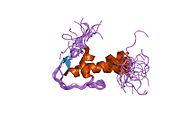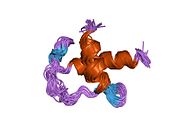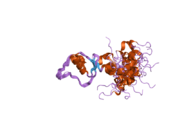Protein-coding gene in the species Homo sapiens
| SPINK5 |
|---|
 |
| Available structures |
|---|
| PDB | Ortholog search: PDBe RCSB |
|---|
| List of PDB id codes |
|---|
1H0Z, 1HDL, 1UUC, 1UVF, 1UVG |
|
|
| Identifiers |
|---|
| Aliases | SPINK5, LEKTI, LETKI, NETS, NS, VAKTI, serine peptidase inhibitor, Kazal type 5, serine peptidase inhibitor Kazal type 5 |
|---|
| External IDs | OMIM: 605010; MGI: 1919682; HomoloGene: 4987; GeneCards: SPINK5; OMA:SPINK5 - orthologs |
|---|
| Gene location (Human) |
|---|
 | | Chr. | Chromosome 5 (human)[1] |
|---|
| | Band | 5q32 | Start | 148,025,683 bp[1] |
|---|
| End | 148,137,382 bp[1] |
|---|
|
| Gene location (Mouse) |
|---|
 | | Chr. | Chromosome 18 (mouse)[2] |
|---|
| | Band | 18 B3|18 23.74 cM | Start | 44,096,302 bp[2] |
|---|
| End | 44,155,568 bp[2] |
|---|
|
| RNA expression pattern |
|---|
| Bgee | | Human | Mouse (ortholog) |
|---|
| Top expressed in | - vulva
- gums
- skin of thigh
- gingival epithelium
- oral cavity
- mucosa of pharynx
- human penis
- skin of hip
- skin of arm
- body of tongue
|
| | Top expressed in | - skin of abdomen
- esophagus
- skin of external ear
- lip
- skin of back
- prostate
- lobe of prostate
- belly cord
- left lung lobe
- stomach
|
| | More reference expression data |
|
|---|
| BioGPS |  | | More reference expression data |
|
|---|
|
| Gene ontology |
|---|
| Molecular function | - peptidase inhibitor activity
- serine-type endopeptidase inhibitor activity
| | Cellular component | - cytoplasm
- cytosol
- endoplasmic reticulum membrane
- cell cortex
- endoplasmic reticulum
- perinuclear region of cytoplasm
- epidermal lamellar body
- extracellular region
- intracellular membrane-bounded organelle
| | Biological process | - epidermal cell differentiation
- negative regulation of proteolysis
- negative regulation of serine-type peptidase activity
- negative regulation of peptidase activity
- epithelial cell differentiation
- hair cell differentiation
- extracellular matrix organization
- negative regulation of antibacterial peptide production
- negative regulation of immune response
- regulation of cell adhesion
- negative regulation of angiogenesis
- negative regulation of serine-type endopeptidase activity
- regulation of T cell differentiation
- cornification
- regulation of timing of anagen
| | Sources:Amigo / QuickGO |
|
| Orthologs |
|---|
| Species | Human | Mouse |
|---|
| Entrez | | |
|---|
| Ensembl | | |
|---|
| UniProt | | |
|---|
| RefSeq (mRNA) | |
|---|
NM_001127698
NM_001127699
NM_006846 |
| |
|---|
| RefSeq (protein) | |
|---|
NP_001121170
NP_001121171
NP_006837 |
| |
|---|
| Location (UCSC) | Chr 5: 148.03 – 148.14 Mb | Chr 18: 44.1 – 44.16 Mb |
|---|
| PubMed search | [3] | [4] |
|---|
|
| Wikidata |
| View/Edit Human | View/Edit Mouse |
|
Lympho-epithelial Kazal-type-related inhibitor (LEKTI) also known as serine protease inhibitor Kazal-type 5 (SPINK5) is a protein that in humans is encoded by the SPINK5 gene.[5][6]
Structure and function
LEKTI is a large multidomain serine protease inhibitor expressed in stratified epithelial tissue. It consists of 15 domains that are cleaved into smaller, functional fragments by the protease furin. Only two of these domains (2 and 15) contain 6 evenly spaced cysteines responsible for 3 intramolecular disulfide bonds characteristic of Kazal-type related inhibitors. The remaining domains contain 4 cysteines.[7] These disulfide bonds force the molecule into a rigid conformation that enables the protein to interact with a target protease via an extended beta-sheet. All domains (excepting 1, 2 and 15) contain an arginine at P1, indicating trypsin-like proteases are the likely targets.[7]
In the epidermis, LEKTI is implicated in the regulation of desquamation via its ability to selectively inhibit KLK5, KLK7 and KLK14.[8] Recombinant full length LEKTI inhibits the exogenous serine proteases trypsin, plasmin, subtilisin A, cathepsin G and human neutrophil elastase.[9]
LEKTI may play a role in skin and hair morphogenesis and anti-inflammatory and/or antimicrobial protection of mucous epithelia.[6]
Gene
SPINK5 is a member of a gene family cluster located on chromosome 5q32,[10] which encode inhibitors of serine proteases. This includes other epidermal proteins SPINK6 and LEKTI-2 (SPINK9). The SPINK5 gene is 61 kb in length and contains 33 exons.[7] Alternative processing of SPINK5 results in the formation of three different gene products, which have been identified in differentiated keratinocytes.[11]
Clinical significance
Mutations in the SPINK5 gene result in Netherton syndrome, a disorder characterized by ichthyosis and specific immune system defects.[6]
See also
References
- ^ a b c GRCh38: Ensembl release 89: ENSG00000133710 – Ensembl, May 2017
- ^ a b c GRCm38: Ensembl release 89: ENSMUSG00000055561 – Ensembl, May 2017
- ^ "Human PubMed Reference:". National Center for Biotechnology Information, U.S. National Library of Medicine.
- ^ "Mouse PubMed Reference:". National Center for Biotechnology Information, U.S. National Library of Medicine.
- ^ Magert HJ, Standker L, Kreutzmann P, Zucht HD, Reinecke M, Sommerhoff CP, Fritz H, Forssmann WG (Aug 1999). "LEKTI, a novel 15-domain type of human serine proteinase inhibitor". J Biol Chem. 274 (31): 21499–502. doi:10.1074/jbc.274.31.21499. PMID 10419450.
- ^ a b c "Entrez Gene: SPINK5 serine peptidase inhibitor, Kazal type 5".
- ^ a b c Furio L, Hovnanian A (November 2011). "When Activity Requires Breaking Up: LEKTI Proteolytic Activation Cascade for Specific Proteinase Inhibition". J Invest Dermatol. 131 (11): 2169–73. doi:10.1038/jid.2011.295. PMID 21997416.
- ^ Deraison C, Bonnart C, Lopez F, Besson C, Robinson R, Jayakumar A, Wagberg F, Brattsand M, Hachem JP, Leonardsson G, Hovnanian A (September 2007). "LEKTI fragments specifically inhibit KLK5, KLK7, and KLK14 and control desquamation through a pH-dependent interaction". Mol. Biol. Cell. 18 (9): 3607–19. doi:10.1091/mbc.E07-02-0124. PMC 1951746. PMID 17596512.
- ^ Mitsudo K, Jayakumar A, Henderson Y, Frederick MJ, Kang Y, Wang M, El-Naggar AK, Clayman GL (April 2003). "Inhibition of serine proteinases plasmin, trypsin, subtilisin A, cathepsin G, and elastase by LEKTI: a kinetic analysis". Biochemistry. 42 (13): 3874–81. doi:10.1021/bi027029v. PMID 12667078.
- ^ "SPINK5 serine peptidase inhibitor, Kazal type 5 [Homo sapiens (human)] - Gene - NCBI".
- ^ Tartaglia-Polcini A, Bonnart C, Micheloni A, Cianfarani F, Andrè A, Zambruno G, Hovnanian A, D'Alessio M (February 2006). "SPINK5, the defective gene in netherton syndrome, encodes multiple LEKTI isoforms derived from alternative pre-mRNA processing". J Invest Dermatol. 126 (2): 315–24. doi:10.1038/sj.jid.5700015. PMID 16374478.
Further reading
- Norgett EE, Kelsell DP (2002). "SPINK5: both rare and common skin disease". Trends in Molecular Medicine. 8 (1): 7. doi:10.1016/S1471-4914(01)02228-6. PMID 11796258.
- Mägert HJ, Kreutzmann P, Ständker L, et al. (2002). "LEKTI: a multidomain serine proteinase inhibitor with pathophysiological relevance". Int. J. Biochem. Cell Biol. 34 (6): 573–6. doi:10.1016/S1357-2725(01)00179-0. PMID 11943586.
- Walden M, Kreutzmann P, Drögemüller K, et al. (2003). "Biochemical features, molecular biology and clinical relevance of the human 15-domain serine proteinase inhibitor LEKTI". Biol. Chem. 383 (7–8): 1139–41. doi:10.1515/BC.2002.124. PMID 12437098. S2CID 26084613.
- Chavanas S, Garner C, Bodemer C, et al. (2000). "Localization of the Netherton syndrome gene to chromosome 5q32, by linkage analysis and homozygosity mapping". Am. J. Hum. Genet. 66 (3): 914–21. doi:10.1086/302824. PMC 1288172. PMID 10712206.
- Chavanas S, Bodemer C, Rochat A, et al. (2000). "Mutations in SPINK5, encoding a serine protease inhibitor, cause Netherton syndrome". Nat. Genet. 25 (2): 141–2. doi:10.1038/75977. PMID 10835624. S2CID 40421711.
- Sprecher E, Chavanas S, DiGiovanna JJ, et al. (2001). "The spectrum of pathogenic mutations in SPINK5 in 19 families with Netherton syndrome: implications for mutation detection and first case of prenatal diagnosis". J. Invest. Dermatol. 117 (2): 179–87. doi:10.1046/j.1523-1747.2001.01389.x. PMID 11511292.
- Walley AJ, Chavanas S, Moffatt MF, et al. (2001). "Gene polymorphism in Netherton and common atopic disease". Nat. Genet. 29 (2): 175–8. doi:10.1038/ng728. PMID 11544479. S2CID 20292050.
- Ahmed A, Kandola P, Ziada G, Parenteau N (2002). "Purification and partial amino acid sequence of proteins from human epidermal keratinocyte conditioned medium". J. Protein Chem. 20 (4): 273–8. doi:10.1023/A:1010902815953. PMID 11594460. S2CID 11877191.
- Bitoun E, Chavanas S, Irvine AD, et al. (2002). "Netherton syndrome: disease expression and spectrum of SPINK5 mutations in 21 families". J. Invest. Dermatol. 118 (2): 352–61. doi:10.1046/j.1523-1747.2002.01603.x. PMID 11841556.
- Komatsu N, Takata M, Otsuki N, et al. (2002). "Elevated stratum corneum hydrolytic activity in Netherton syndrome suggests an inhibitory regulation of desquamation by SPINK5-derived peptides". J. Invest. Dermatol. 118 (3): 436–43. doi:10.1046/j.0022-202x.2001.01663.x. hdl:2297/15796. PMID 11874482.
- Bitoun E, Micheloni A, Lamant L, et al. (2004). "LEKTI proteolytic processing in human primary keratinocytes, tissue distribution and defective expression in Netherton syndrome". Hum. Mol. Genet. 12 (19): 2417–30. doi:10.1093/hmg/ddg247. PMID 12915442.
- Nishio Y, Noguchi E, Shibasaki M, et al. (2004). "Association between polymorphisms in the SPINK5 gene and atopic dermatitis in the Japanese". Genes Immun. 4 (7): 515–7. doi:10.1038/sj.gene.6363889. PMID 14551605.
- Raghunath M, Tontsidou L, Oji V, et al. (2004). "SPINK5 and Netherton syndrome: novel mutations, demonstration of missing LEKTI, and differential expression of transglutaminases". J. Invest. Dermatol. 123 (3): 474–83. doi:10.1111/j.0022-202X.2004.23220.x. PMID 15304086.
- Tidow H, Lauber T, Vitzithum K, et al. (2004). "The solution structure of a chimeric LEKTI domain reveals a chameleon sequence" (PDF). Biochemistry. 43 (35): 11238–47. doi:10.1021/bi0492399. PMID 15366933.
- Yang T, Liang D, Koch PJ, et al. (2004). "Epidermal detachment, desmosomal dissociation, and destabilization of corneodesmosin in Spink5-/- mice". Genes Dev. 18 (19): 2354–8. doi:10.1101/gad.1232104. PMC 522985. PMID 15466487.
- Ishida-Yamamoto A, Deraison C, Bonnart C, et al. (2005). "LEKTI is localized in lamellar granules, separated from KLK5 and KLK7, and is secreted in the extracellular spaces of the superficial stratum granulosum". J. Invest. Dermatol. 124 (2): 360–6. doi:10.1111/j.0022-202X.2004.23583.x. PMID 15675955.
External links
- Overview of all the structural information available in the PDB for UniProt: Q9NQ38 (Serine protease inhibitor Kazal-type 5) at the PDBe-KB.
PDB gallery
-
1h0z: LEKTI DOMAIN SIX -
1hdl: LEKTI DOMAIN ONE -
1uuc: SOLUTION STRUCTURE OF A CHIMERIC LEKTI-DOMAIN -
1uvf: SOLUTION STRUCTURE OF THE STRUCTURED PART OF THE 15TH DOMAIN OF LEKTI -
1uvg: SOLUTION STRUCTURE OF THE 15TH DOMAIN OF LEKTI |
 | This article on a gene on human chromosome 5 is a stub. You can help Wikipedia by expanding it. |

 1h0z: LEKTI DOMAIN SIX
1h0z: LEKTI DOMAIN SIX 1hdl: LEKTI DOMAIN ONE
1hdl: LEKTI DOMAIN ONE 1uuc: SOLUTION STRUCTURE OF A CHIMERIC LEKTI-DOMAIN
1uuc: SOLUTION STRUCTURE OF A CHIMERIC LEKTI-DOMAIN 1uvf: SOLUTION STRUCTURE OF THE STRUCTURED PART OF THE 15TH DOMAIN OF LEKTI
1uvf: SOLUTION STRUCTURE OF THE STRUCTURED PART OF THE 15TH DOMAIN OF LEKTI 1uvg: SOLUTION STRUCTURE OF THE 15TH DOMAIN OF LEKTI
1uvg: SOLUTION STRUCTURE OF THE 15TH DOMAIN OF LEKTI





















